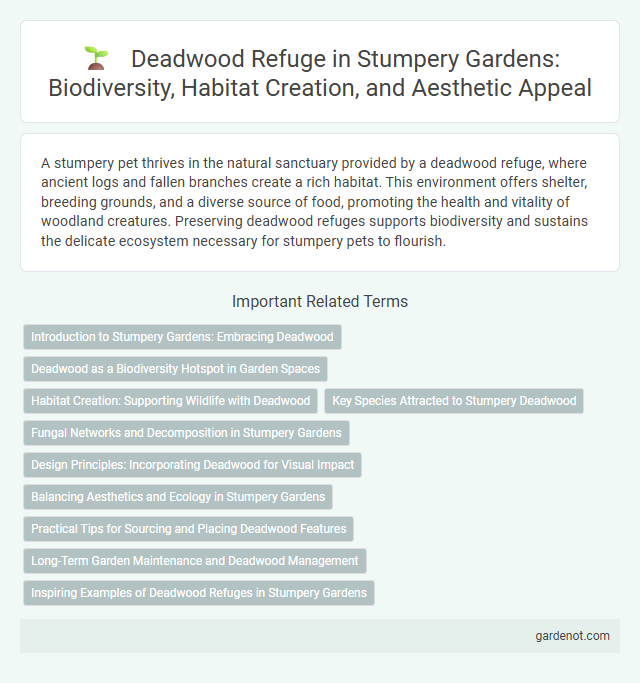A stumpery pet thrives in the natural sanctuary provided by a deadwood refuge, where ancient logs and fallen branches create a rich habitat. This environment offers shelter, breeding grounds, and a diverse source of food, promoting the health and vitality of woodland creatures. Preserving deadwood refuges supports biodiversity and sustains the delicate ecosystem necessary for stumpery pets to flourish.
Introduction to Stumpery Gardens: Embracing Deadwood
Stumpery gardens uniquely showcase the beauty of deadwood, transforming fallen branches and tree roots into artistic natural sculptures. This technique provides a refuge for wildlife, promoting biodiversity by creating habitats for insects, fungi, and small animals. Embracing deadwood in garden design enhances soil health and conserves resources through sustainable landscaping practices.
Deadwood as a Biodiversity Hotspot in Garden Spaces
Deadwood serves as a crucial biodiversity hotspot within garden spaces, providing essential habitats for a wide range of flora and fauna. Its complex structures create microhabitats that support insects, amphibians, and small mammals, enhancing ecological balance and promoting species diversity. Integrating deadwood refuges in stumperies fosters natural decomposition processes and nutrient cycling, enriching soil health and plant growth.
Habitat Creation: Supporting Wildlife with Deadwood
Deadwood refuge creates vital habitats by preserving fallen and decaying wood, which supports a diverse range of wildlife including insects, fungi, and small mammals. This natural decomposition process enriches the soil and provides shelter and breeding grounds, fostering biodiversity within woodland ecosystems. Maintaining deadwood in stumperies enhances ecological resilience and promotes the survival of rare and endangered species.
Key Species Attracted to Stumpery Deadwood
Deadwood in stumperies provides essential habitat for a variety of key species, including rare beetles like the Violet Ground Beetle (Carabus violaceus) and the Lesser Stag Beetle (Dorcus parallelipipedus). Fungi such as the Dead Man's Fingers (Xylaria polymorpha) thrive on decaying wood, promoting nutrient cycling and biodiversity. Woodland birds like the Great Spotted Woodpecker benefit from the abundant insect prey living within the deadwood structures.
Fungal Networks and Decomposition in Stumpery Gardens
Deadwood refuge in stumpery gardens fosters vital fungal networks essential for nutrient cycling and organic decomposition. These interconnected mycelial systems accelerate the breakdown of woody debris, enriching soil fertility and supporting diverse plant ecosystems. Stumperies create optimal habitats for saprotrophic fungi that drive decomposition, enhancing biodiversity and ecosystem resilience.
Design Principles: Incorporating Deadwood for Visual Impact
Incorporating deadwood into stumpery design enhances visual impact by emphasizing natural textures and organic forms that create a rustic, woodland aesthetic. Strategic placement of deadwood pieces maximizes depth and contrast, drawing attention to their intricate shapes while supporting plant growth like ferns and mosses. This approach not only elevates the visual appeal but also fosters biodiversity by providing habitat for insects and small wildlife.
Balancing Aesthetics and Ecology in Stumpery Gardens
Deadwood refuges within stumpery gardens create vital habitats for diverse wildlife species, enhancing local biodiversity while preserving natural decay processes. Thoughtful placement of rotting logs and branches promotes fungi growth and supports invertebrates, fostering a balanced ecosystem alongside ornamental plantings. Integrating ecological functions with visual appeal turns stumperies into dynamic, sustainable garden features that both delight the eye and nurture environmental health.
Practical Tips for Sourcing and Placing Deadwood Features
Selecting deadwood with varying textures and sizes enhances visual interest and mimics natural woodland environments in a stumpery. Positioning logs and branches in partially shaded areas promotes moss and lichen growth, adding to the habitat's ecological value. Ensure deadwood is stable and secure to provide safe refuge spots for insects, amphibians, and small mammals.
Long-Term Garden Maintenance and Deadwood Management
Long-term garden maintenance in a stumpery involves careful deadwood management to promote habitat diversity and structural integrity. Regular assessment and repositioning of deadwood pieces prevent decay and support beneficial microorganisms, enhancing soil health. Integrating sustainable practices ensures the stumpery remains a resilient refuge for wildlife over time.
Inspiring Examples of Deadwood Refuges in Stumpery Gardens
Deadwood refuges in stumpery gardens create vital habitats for insects, fungi, and small mammals by mimicking natural woodland decay processes. Examples of inspiring deadwood refuges include intricately stacked logs, partially buried branches, and moss-covered stumps that promote biodiversity and enhance garden ecology. These refuges support pollinators and decomposers, contributing to soil health and the overall resilience of garden ecosystems.
Deadwood refuge Infographic

 gardenot.com
gardenot.com